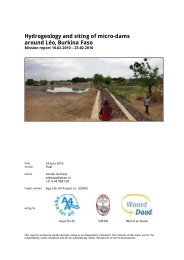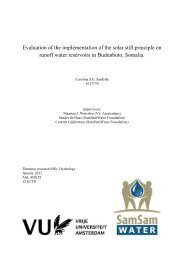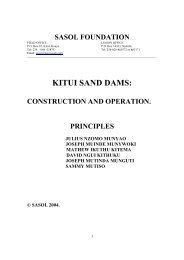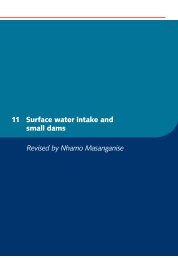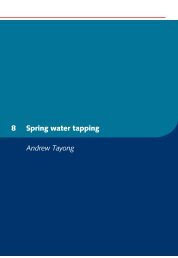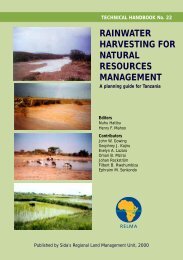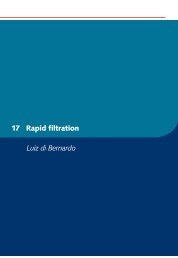Water from Small Dams
Water from Small Dams - SamSamWater
Water from Small Dams - SamSamWater
Create successful ePaper yourself
Turn your PDF publications into a flip-book with our unique Google optimized e-Paper software.
7.6 Borrow pitAnalysis of soil samples will show whether a borrow pit in the floor of a reservoir canprovide the most clayey soil for making a watertight key and foundation of the dam wall.The excavation of the borrow pit within the reservoir has the advantage of enlarging thereservoir volume and also not leaving any scar on the landscape as the borrow pit will besubmerged when the reservoir fills. It is however important that the depth of a borrow pitis never deeper than the bottom of the key, because otherwise water might seep under thekey emptying the reservoir. A borrow pit must be at least 10 metres upstream of the fronttoe of the dam wall to avoid seepage under the wall.7.7 Building the dam wallTo reduce the need to transport soil, the key and the lower part of a dam wall should bebuilt of soil excavated <strong>from</strong> a borrow pit dug in the floor of the reservoir. The upper partof a dam wall is built of soil excavated <strong>from</strong> its spillways. When a key has beencompacted with clayey soil and the foundation has been cleared of vegetation, roots andsandy soil, the construction of a dam wall can begin as follows:The key under a dam wallThe top soil of a borrow pit and spillways is usually the most clayey soil and shouldtherefore be used for building the watertight key under the dam wall.The core in the middle of a dam wallA core is an extension of the keyand its purpose is to preventwater seeping through dam wallsmade of sandy soils. A core isbuilt in layers of about 20 cmthicknesses upon the key andcompacted for each layer untilthe height of the maximum waterlevel is reached withoutbothering about the final width ofthe dam wall. This is because it isimportant to reach the finalheight of the core before an The core of an earth dam is built of clayey soil,unexpected thunderstorm may while sandy soil is used for the upstream andproduce a flood that could wash downstream sides of the dam wall.away a dam wall that is too low.Experience has shown that 30% height must be added to the core to compensate for thesettling of soil during flooding of the water reservoir.The sides of a dam wallWhen the core has reached its final height, the sides of the dam wall are built to theirfinal gradients and height. Several nylon strings are drawn <strong>from</strong> the crest to the outline ofthe upstream and downstream foundation to show the gradients.49



